Théodore Rousseau: La Voix de la forêt (Théodore Rousseau: The Voice of the Forest)
Reviewed by Joy CadorJoy Cador
Paris 1 Pantheon-Sorbonne University
Email the author: joy.cador[at]sciencespo.fr
Citation: Joy Cador, exhibition review of Théodore Rousseau: La Voix de la forêt (Théodore Rousseau: The Voice of the Forest), Nineteenth-Century Art Worldwide 23, no. 2 (Autumn 2024), https://doi.org/10.29411/ncaw.2024.23.2.19.
This work is licensed under a Creative Commons Attribution-NonCommercial 4.0 International License  unless otherwise noted.
unless otherwise noted.
Your browser will either open the file, download it to a folder, or display a dialog with options.
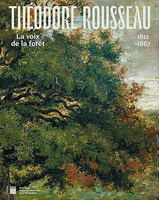
Théodore Rousseau: La Voix de la forêt (Théodore Rousseau: The Voice of the Forest)
Petit Palais Museum, Paris
March 5–July 7, 2024
Servane Dargnies-de Vitry, ed.,
Théodore Rousseau (1812–1867): La voix de la forêt (Théodore Rousseau (1812–1867): The Voice of the Forest).
Paris: Paris Musées, 2024.
208 pp.; 139 illus.
€35.00 (hardcover)
ISBN: 782759605743
Théodore Rousseau: La Voix de la forêt (Théodore Rousseau: The Voice of the Forest), curated by Servane Dargnies-de Vitry of the Musée d’Orsay, follows numerous exhibitions organized in France, such as Nous les arbres (We the Trees; Paris, Fondation Cartier pour l’art contemporain, 2019–20) and La Forêt (The Forest; Lille, Palais des Beaux-Arts, 2022), that seek to shape visitors’ ecological awareness. While the ecological question is not the sole focus of this retrospective—it is only addressed directly in the last sections—the theme of the forest points to the necessity of protecting woodlands from damaging human actions. Indeed, following Greg Thomas’s Art and Ecology in Nineteenth-Century France: The Landscapes of Théodore Rousseau (2000), in which Thomas argued that Rousseau was not “importing ecological ideas from science but developing [an] ecological visual attitude out of the practice of landscape painting,” Rousseau has been associated with forest preservation.[1]
Rousseau was famously rejected from the French Salon during his lifetime and had nearly fallen into oblivion by 1910. While Rousseau’s work was often part of larger exhibitions treating the Fontainebleau Forest, as, for example, in Barbizon Revisited (San Francisco Museum of Art, 1962) and La forêt de Fontainebleau: un atelier grandeur nature (The Fontainebleau Forest: A Studio on the Scale of Nature; Musée d’Orsay, 2007), monographic exhibitions have remained scarce. The 2016 exhibition Unruly Nature: The Landscapes of Théodore Rousseau, held at the Getty Museum (Los Angeles), stands as a landmark for shedding light on Rousseau’s work in the United States.[2] Moreover, as Alexis Clark has underlined, Rousseau and others of the Barbizon school have at times been “pushed to Impressionism’s long shadow, for instance The Origins of Impressionism (Grand Palais, Paris and Metropolitan Museum of Art, 1994–95) or Inspiring Impressionism: Daubigny, Monet, Van Gogh (National Galleries of Scotland, Edinburgh, 2015).”[3] In Paris during the spring of 2024, however, Rousseau and the Impressionist painters were openly separated and juxtaposed. While Rousseau’s works were on display at the Petit Palais, the Musée d’Orsay celebrated the 150th anniversary of the first Impressionist exhibition with a major exhibition devoted to the movement.
This exhibition emphasizes Rousseau’s romantic side: its title is directly inspired by the painter’s own words, “I was also listening to the voices of the trees,”[4] recalling the holistic conception of the world characteristic of romantic artists and writers. Moreover, as director of the Petit Palais Museum Annick Lemoine highlights, the ecological theme would not have been adequately established by simply reexhibiting Rousseau’s paintings from the 2016 show in US institutions, especially given the significant carbon footprint that would have resulted from so many loans. That is why the artworks presented are mainly taken from French and other European institutions.
The exhibition begins not with Rousseau’s paintings, but with the forest itself. The first room displays scenography designed by Violette Cros of the Cros & Patras agency (fig. 1). It employs a komorebi effect, a term referring to the sunlight shining through the tree’s leaves. The allusion to Japan is particularly relevant here because of the importance of trees in Japanese culture.[5]
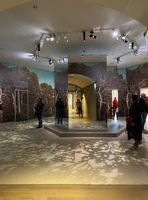
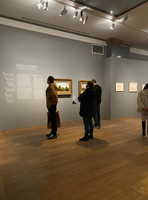
The exhibition is then divided into six sections. The first, entitled “Revolutionizing Landscape Painting,” presents Rousseau’s early works, recalling his background and contextualizing his artistic production (fig. 2). Rousseau studied in the workshop of French landscape painter Jean-Charles-Joseph Rémond, a master of “historical landscape.” While Rousseau took part in the Grand Prix de Rome competition, he abandoned the modes of landscape favored by the Academy. Following this decision, he traveled throughout France. The first gallery in the exhibition brings together works Rousseau realized during this period of travel. These works are very eclectic, with the painter using different techniques—from oil on canvas to watercolor—indicating a holistic conception of nature. Indeed, while Study of the Tree Trunks (1833; Musée des Beaux-Arts, Strasbourg, fig. 3) testifies to the artist’s microscopic approach to his environment, one of the most impressive paintings in the first room is Mont-Blanc Seen from La Faucille (fig. 4), its panoramic view conferring a cosmic dimension on the work.
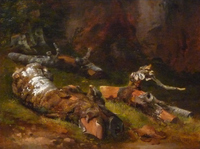
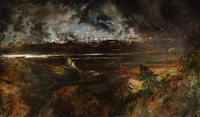
Rousseau’s nickname, “The Great Rejected One,” provides the title of the second section (fig. 5). He acquired the moniker after his paintings were systematically rejected from the French Salons that took place from 1836 to 1848. This section focuses especially on Rousseau’s techniques, which help to explain why his paintings were rejected. Rousseau was well-known for not finishing his works, as noted on a wall text: “Finishing was the great bane of his life, because of the fundamental tension between his desire to capture reality and to imbue it with his soul.” A quotation by François Sabatier-Ungher sums up an important aspect of Rousseau’s vision: “And what if these were only sketches? Who cares if they say more than a finished work? And what, for god’s sake, is a finished work?”[6] This room underlines Rousseau’s attempt to mix drawing and painting and to blur the boundaries of different mediums and between sketches and final works.
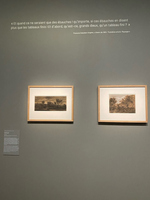

The room also illuminates Rousseau’s creative process: the wall label for The Avenue of Chestnut Trees (fig. 6), for example, indicates that Rousseau started the work outside, in nature, before retouching it in his workshop over the course of several years. Furthermore, Rousseau animated the surface of his works with different textures, a process that, among other things, allowed him to imitate the rough surface of trees. The attention accorded to the texture of his landscape recalls Rousseau’s interest in John Constable, and the catalogue notes that the display of the Hay Wain (1821; National Gallery, London) at the 1824 Salon deeply marked the French art school, especially the landscape painters. The exhibition, however, does not emphasize enough the influence of Constable’s technique in France. Stendhal, for one, noted that, “The carelessness of Mr. Constable’s brush is exaggerated, and the planes of his pictures are not well observed. What is more, he has no ideal, but his delightful landscape, with a dog on the left, is the mirror of nature.”[7] Lifting the veil on the “Grand Refusé” myth, this section also reveals how this position was beneficial to the artist as Rousseau’s paintings became highly successful among private collectors, a point Simon Kelly recently established in his book Théodore Rousseau and the Rise of the Modern Art Market (2021).[8]
The following section, “Barbizon: The Village of Artists,” operates a slight shift, as the focus moves to the Barbizon School, an international community of artists located in and around the Fontainebleau Forest and of which Rousseau was a leading figure (fig. 7). Paintings by Jean-François Millet (fig. 8), Charles Jacques, and Constant Troyon reveal Rousseau’s legacy on a whole artistic community as well as the divergences that existed between him and the other Barbizon painters (fig. 9).
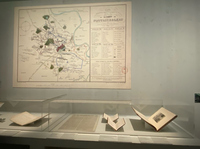
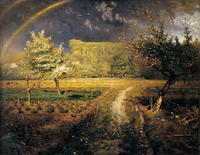
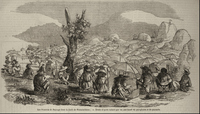
Section 4, “Fontainebleau: the Forest as Refuge,” specifically addresses the forest, as does section 5, “The Voice of the Trees” (figs. 10, 11). The first emphasizes Rousseau’s pantheism. Indeed, Rousseau’s view of landscape seems to meet the German romantic painter Carl Gustav Carus’s Erdlebenbild, a term referring to a nature that is gifted with a “soul” and in constant motion.[9] In Rousseau’s work, viewers are not outside of the canvas but in the middle of it. As Dargnies-de Vitry has shown, Rousseau abandoned geometric perspective to place humans in the center of his own universe. Leon Battista Alberti defined painting as “an open window through which the subject to be painted is seen,”[10] but Rousseau’s paintings do not open windows on the world; they are themselves a sort of cosmos with the viewers in the middle.
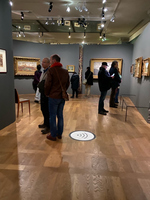
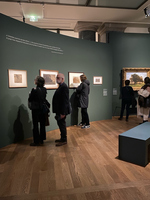
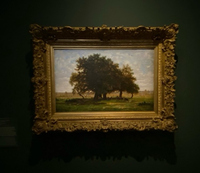
The following section is devoted to one of Rousseau’s specialties, namely, portraits of trees (fig. 12). Once again, these works recall Constable, especially his Study of the Trunk of an Elm Tree (1821; Victoria and Albert Museum, London), which was displayed in the exhibition La Forêt at the Palais des Beaux-Arts of Lille in 2022. These portraits subvert André Félibien’s well-established hierarchy of genres in which portraiture was considered of a higher order than still life or landscape because, “as the human figure is God’s most perfect work on earth, it is certainly the case that the artist who imitates God by painting human figures is more outstanding by far than all the others.”[11] This hierarchy was repeatedly challenged from the eighteenth century onward, but Rousseau invested trees with unprecedented dignity akin to that which was normally reserved for human figures.
The last section, “Rousseau: an Ecologist?” (fig. 13), explicitly tackles the issue of ecology. With his Massacre of the Innocents (1847; The Mesdag Collection, The Hague), Rousseau raised landscape painting to the level of history painting (fig. 14). As Dargnies-de Vitry recalls in both the catalogue and the wall text, since the 1840s the Fontainebleau Forest has become an object of high concern for writers and artists, as it was transformed by both tourism and the industrial revolution. Some of Rousseau’s paintings use fallen trees to alert viewers to the dangers of human exploitation, so Rousseau himself became an advocate of the forest (see, e.g., fig. 15). He even wrote to the French Minister of Home Affairs, asking for the forest to be preserved and protected. Consequently, the Fontainebleau Forest became the first “artistic reserve” in 1853, a designation that was made official in 1861.
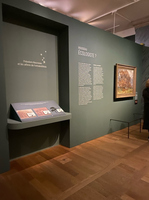
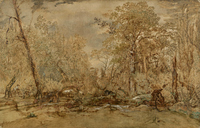
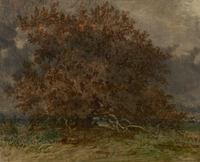
The exhibition ends with a timeline showing the evolution of the Fontainebleau Forest from the beginning of the nineteenth century to the present (figs. 16, 17). The establishment of various institutions, such as Les Amis de la Forêt (Friends of the Forest; founded 1907) and the first municipal museum dedicated to Fontainebleau (which opened in Rousseau’s former studio in 1927) reveal Rousseau’s legacy on the history of the forest.
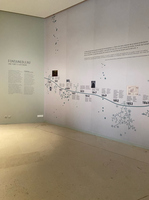
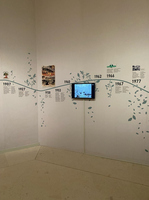
The exhibition was enhanced by a remarkable educational program (figs. 18, 19). Throughout the exhibition, educational tools assisted young audiences in understanding the ground-breaking aspect of Rousseau’s works, compared his landscapes to those of his master, and identified the specificities of his touch and the characteristics of his palette. In some spaces, it was also possible to hear the “voices of the forest” through sound installations. An ambitious lecture program also accompanied the exhibition: Dominique de Font-Réaulx provided a photographic workshop (photography was also explored in the catalogue), and Gilles Clément lent his expertise as a gardener to another session. Additional artistic activities and performances made for both young and general audiences developed other aspects of the forest.
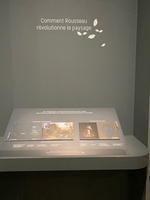
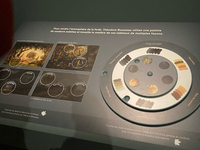
The catalogue gathers texts from an array of international specialists: Michel Schulman, author of Rousseau’s catalogue raisonné; Simon Kelly, curator and head of the Department of Modern and Contemporary Art at the Saint Louis Art Museum; Greg M. Thomas, professor at the University of Hong Kong; Edouard Kopp, co-curator of the 2007 exhibition at the Getty; Asher Miller, associate curator at the Metropolitan Museum of Art; Renske Suijver, curator at the Van Gogh Museum & the Mesdag Collection; and French curators and scholars including Dargnies-de Vitry; Sandra Buratti-Hasan, curator at the Musée des Beaux-Arts of Bordeaux; Chantal Georgel, a chief curator who notably took part in the scientific committee that was in charge of elaborating the application file for the inscription of the Fontainebleau Forest on the UNESCO World Heritage List; Dominique de Font-Réaulx, curator at the Musée du Louvre and an expert in nineteenth-century photography; and Dr. Pierre Wat, a professor at Paris 1 Panthéon-Sorbonne University specializing in nineteenth-century landscape painting.[12]
Some of these contributions explored themes in the exhibition more deeply: Kopp’s essay focuses on Rousseau’s drawing practice, while Dargnies-de Vitry questions the myth of Rousseau as the “Grand Refusé,” and Georgel explores Rousseau’s appropriation of the forest. Wat tackles the ecological question, arguing that Fontainebleau was relatively devoid of any animal life, thereby explaining the similar absence in Rousseau’s paintings. Wat concludes his essay by arguing, “as a patriot, Rousseau defends the idea of the nation. It is not clear that this meshes with an ecological sensibility. What is certain is that in wanting to preserve this romantic and heritage forest for tourists and painters, Rousseau was using his talents to plead as much for the interests of the predators as for the protectors of the prey” (169).[13]
Théodore Rousseau: La Voix de la forêt reveals new perspectives on Rousseau’s techniques, reception, and relation to nature. While the painter’s ecological awareness is contextualized and questioned, the fact remains that, given the current climate and other environmental issues, Rousseau has much to offer in shaping our ecological eye and making us more sensitive to the nature that surrounds us.
Notes
[1] Greg M. Thomas, Art and Ecology in Nineteenth-Century France: The Landscapes of Théodore Rousseau (Princeton: Princeton University Press, 2000).
[2] Alexis Clark, “Review of Unruly Nature: The Landscapes of Théodore Rousseau,” Nineteenth-Century Art Worldwide 16, no. 1 (Spring 2017), https://doi.org/10.29411/ncaw.2017.16.1.10.
[3] Alexis Clark, Review of Unruly Nature: The Landscapes of Théodore Rousseau, https://doi.org/10.29411/ncaw.2017.16.1.10.
[4] “J’entendais aussi les voix des arbres.” Théodore Rousseau quoted in Alfred Sensier, Souvenirs sur Théodore Rousseau (Paris: Léon Techener et Durand-Ruel, 1872), 52. Unless otherwise noted, all translations are by the author.
[5] Several publications deal with the place of the woods and forest in Japanese culture. See, for instance, Christoph Henrichsen, Japan. Culture of Wood: Buildings, Objects, Techniques (Basel, Birkhäuser, 2004). For a more cultural perspective, see also Nicolas Alban and Caroline Berwick, “Forêt et religion au Japon: d’une vision singulière de l’arbre à une gestion particulière de la forêt,” Revue forestière française 56, no. 6 (2004): 563–72.
[6] “Et quand ce ne seraient que des ébauches! qu’importe, si ces ébauches en disent plus que les tableaux finis! Et d’abord, qu’est-ce, grands dieux, qu’un tableau fini?.” François Sabatier-Ungher, “Salon de 1851. Troisième article. Paysage,” La Démocratie pacifique, journal des intérêts des gouvernements et des peuples, January 12, 1851, 6–7.
[7] “La négligence du pinceau de M. Constable est outrée, et les plans de ses tableaux ne sont pas bien observés, d’ailleurs il n’a aucun idéal, mais son délicieux paysage, avec un chien à gauche, est le miroir de la nature.” Quoted in Sarah Gould, “Constable au Salon de Paris: un peintre anglais déroute les critiques français,” RetroNews (2020), https://shs.hal.science/.
[8] See Kelly Presutti, book review of Théodore Rousseau and the Rise of the Modern Art Market by Simon Kelly, Nineteenth-Century Art Worldwide 23, no. 1 (Spring 2024), https://doi.org/10.29411/ncaw.2024.23.1.14.
[9] See Adèle Akamatsu, review of Carl Gustav Carus, Neun Briefe über Landschaftsmalerei, ed. by André Georgi with an afterword by Werner Busch, Regards Croisés. Revue franco-allemande d’histoire de l’art et d’esthétique, no. 12 (2022), https://doi.org/10.57732/rc.2022.12.94985.
[10] Leon Battista Alberti, On Painting, trans. Cecil Grayson (London: Phaidon, 1972), 55.
[11] Quoted in Steve Edwards, Art and Its Histories: A Reader (New Haven: Yale University Press, 1999), 35.
[12] See especially Pierre Wat, Pérégrinations: Paysages entre nature et histoire (Paris: Hazan, 2017).
[13] “C’est donc bien l’idée de nation que défend Rousseau le patriote. Il n’est pas certain que cela fasse bon mariage avec le sentiment écologique. Ce qui est sûr, c’est qu’en voulant préserver cette forêt romantique et patrimonial pour les touristes et les peintres, Rousseau ignore qu’il plaide alors avec talent tant pour les intérêts du prédateur que pour la protection de la proie.”